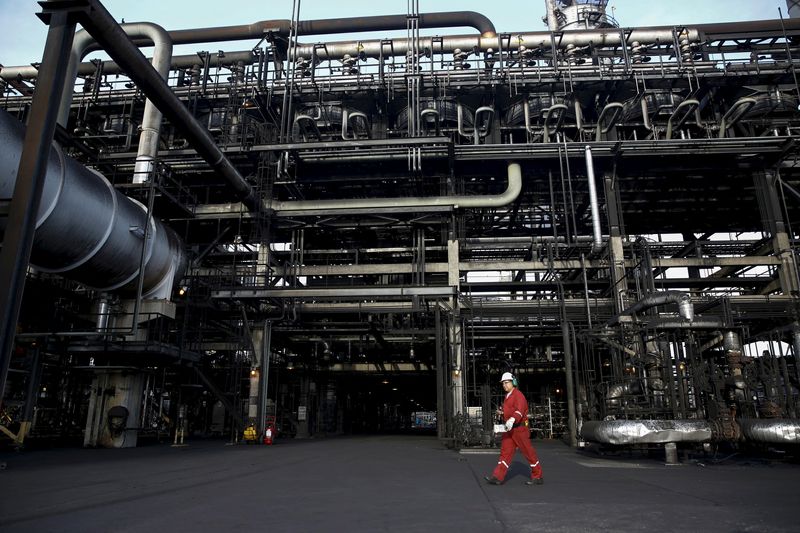Venezuela’s February oil exports rise, but shipping delays persist By Reuters
[ad_1]

© Reuters. FILE PHOTO: An oilfield worker walks next to pipelines at PDVSA’s Jose Antonio Anzoategui industrial complex in the state of Anzoategui April 15, 2015. REUTERS/Carlos Garcia Rawlins/File Photo
By Marianna Parraga and Mircely Guanipa
(Reuters) – Venezuela’s oil exports slightly increased in February to some 670,000 barrels per day (bpd), but ongoing shipping delaysworsened a bottleneck of tankers waiting to load, according to documents and vessel monitoring data.
State-run oil firm PDVSA’s customers have rushed to send tankers to Venezuela in recent months to pick up crude and fuel before the United States potentially reimposes oil sanctions.
Restrictions could resume on April 18 when an existing license expires, the U.S. has said, with PDVSA struggling to deliver cargoes ahead of the deadline.
Deliveries last month to clients including U.S.-based Chevron (NYSE:) and India’s Reliance Industries increased from January, but weaker output and a lack of diluents to produce exportable grades prevented PDVSA from raising total exports, the data showed.
PDVSA and its joint ventures exported an average 671,140 bpd of crude and fuel, mainly to Asia, a 7.5% increase from January. Venezuela also shipped 197,000 metric tons of oil byproducts and petrochemicals, below the 286,000 tons in January.
Chevron’s shipments of Venezuelan crude to the U.S. jumped to 184,000 bpd from 107,000 bpd the previous month. Venezuela’s shipments to political ally Cuba remained around 34,000 bpd, while deliveries to other Caribbean islands slightly increased.
Insufficient inventories of flagship Merey 16 crude and a lack of imported diluents at Venezuela’s main oil port, Jose, prevented PDVSA from further boosting exports to fulfill spot supply deals, internal company documents showed.
Some large tankers bound for Asia have left Venezuelan ports without loading in recent days after waiting for weeks, according to LSEG vessel monitoring data.
The Jose terminal has recovered from power outages and slow oil blending that affected loadings in January, the documents showed. Four out of five crude upgraders and blending stations were in service last month, which could lead to higher exports in March.
As of Feb. 29, at least 18 supertankers were waiting to load near Venezuela’s Jose and Amuay ports, which handle most of PDVSA’s exports, up from about a dozen at the end of November, according to the data.
Venezuela’s fuel imports rose to 144,000 bpd from 122,000 bpd in January.
[ad_2]
Source link

© Reuters. FILE PHOTO: An oilfield worker walks next to pipelines at PDVSA’s Jose Antonio Anzoategui industrial complex in the state of Anzoategui April 15, 2015. REUTERS/Carlos Garcia Rawlins/File Photo
By Marianna Parraga and Mircely Guanipa
(Reuters) – Venezuela’s oil exports slightly increased in February to some 670,000 barrels per day (bpd), but ongoing shipping delaysworsened a bottleneck of tankers waiting to load, according to documents and vessel monitoring data.
State-run oil firm PDVSA’s customers have rushed to send tankers to Venezuela in recent months to pick up crude and fuel before the United States potentially reimposes oil sanctions.
Restrictions could resume on April 18 when an existing license expires, the U.S. has said, with PDVSA struggling to deliver cargoes ahead of the deadline.
Deliveries last month to clients including U.S.-based Chevron (NYSE:) and India’s Reliance Industries increased from January, but weaker output and a lack of diluents to produce exportable grades prevented PDVSA from raising total exports, the data showed.
PDVSA and its joint ventures exported an average 671,140 bpd of crude and fuel, mainly to Asia, a 7.5% increase from January. Venezuela also shipped 197,000 metric tons of oil byproducts and petrochemicals, below the 286,000 tons in January.
Chevron’s shipments of Venezuelan crude to the U.S. jumped to 184,000 bpd from 107,000 bpd the previous month. Venezuela’s shipments to political ally Cuba remained around 34,000 bpd, while deliveries to other Caribbean islands slightly increased.
Insufficient inventories of flagship Merey 16 crude and a lack of imported diluents at Venezuela’s main oil port, Jose, prevented PDVSA from further boosting exports to fulfill spot supply deals, internal company documents showed.
Some large tankers bound for Asia have left Venezuelan ports without loading in recent days after waiting for weeks, according to LSEG vessel monitoring data.
The Jose terminal has recovered from power outages and slow oil blending that affected loadings in January, the documents showed. Four out of five crude upgraders and blending stations were in service last month, which could lead to higher exports in March.
As of Feb. 29, at least 18 supertankers were waiting to load near Venezuela’s Jose and Amuay ports, which handle most of PDVSA’s exports, up from about a dozen at the end of November, according to the data.
Venezuela’s fuel imports rose to 144,000 bpd from 122,000 bpd in January.